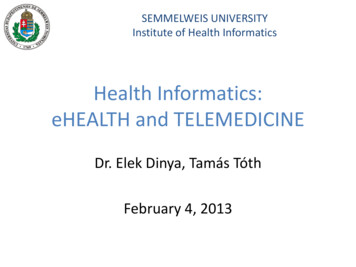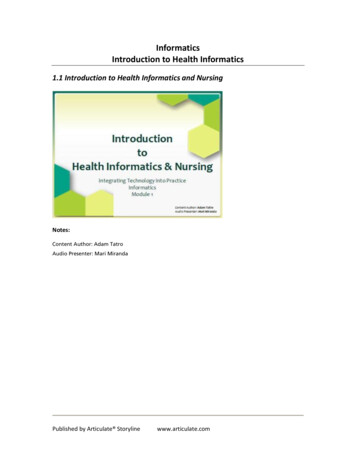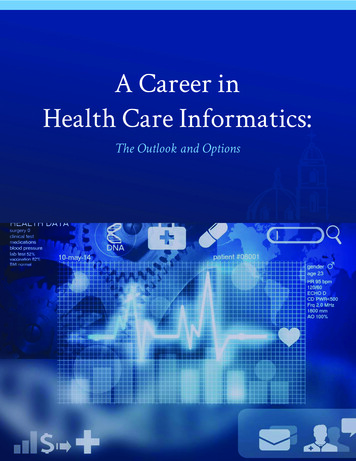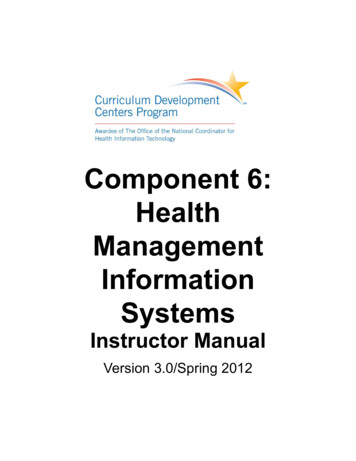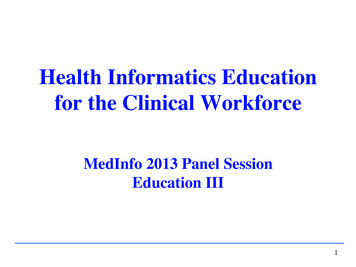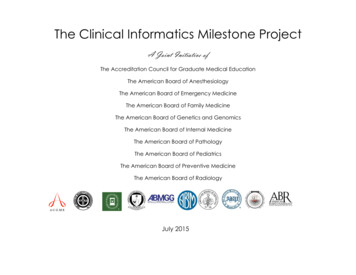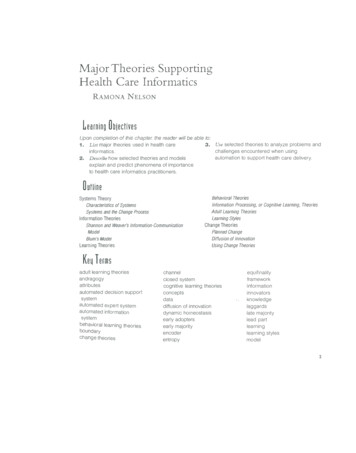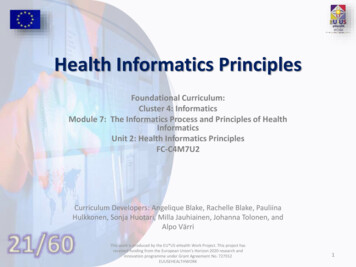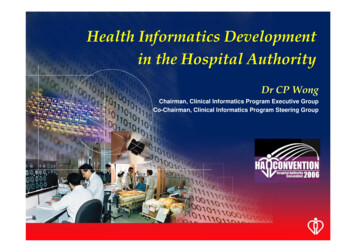
Transcription
Health Informatics Developmentin the Hospital AuthorityDr CP WongChairman, Clinical Informatics Program Executive GroupCo-Chairman, Clinical Informatics Program Steering Group
z Begin to take off in the US as medicalinformatics in 1950z In Hong Kong, before 1990, the term wasunheard of in healthcare field
The Hospital AuthorityApproach to Clinical IT
Objectivesz Enable Reform Facilitate Virtualisation of Health Care Deliveryz Better Governance Approval Process, IT Policies, Standards etc.z Value for Money Better Business Cases, ROI, Benefit Realisationz Reduce Costs Consolidate, Rationalise & Standardise ITz Improve Service Customer Focused ITD, More Communicationz Integrate IT and Business Business to Own/Sponsor/Drive IT SolutionsITD the Advisor, Custodian & Operator of IT
Hospital Authorityz 6.8 million population 43 Public Hospitals 46 Specialists Clinics 74 General Clinics 8.9m Outpatient attendancesz 28,176 Beds (90% market share) 2.4m AED attendances 1.2m Inpatient Dischargesz 52,000 Staff 4,800 Doctors 19,000 Nurses 4,800 Allied Health Staffz Annual Allocated Budget HK 30 billionz Annual IT budget 1.5%
A long journey of developmentz 1990 “Green field” – no legacy systemz 1991 Patient Administration onlyz 1992 Pharmacy System added Dispensing & Labelingz 1993 Lab results onlinez 1994 Radiology Information Systemz 1995 Clinical Management System Order Entry & Outpatient Progress Notesz 2000 Electronic Patient Records Territory wide retrieval of informationz 2004 Radiology Images online
The First IT/IS Strategy 1992-2002z Stage 1 -- Wide AreaNetwork linked all HAinstitutions electronicallyz Established the coreoperational systems thatenabled the collection ofdata for the 4 key databasesof Patients, Staff, Financeand Assets
The First IT/IS Strategy 1992-2002z Stage 2 -- clinical supportsystems at the hospital andclinic levelsz Local Area Networks built inall major hospitals
The First IT/IS Strategy 1992-2002z Stage 3 -- the InformationalSystems and the electronicPatient Record (ePR).
On a Single Platform
The 2nd Largest IT Network in HK
CharacteristicszzzzzWide range of Applications in useEnterprise PMI and Unique Patient ID (HK ID)Only 1.5% of Budget per annumTechnology Standardisation FocusClinical Management System that is used bymost Cliniciansz Centralised Management Focusz Single Platformz Built in-house
Health IT Around The GlobeManageFundingOperationsSoftwareERP SystemCPR SystemDoctors UseOutsourceASP’sLocal VendorHKAustraliaUKUSACorporate1.5% (5%) CentralIn-HouseNoAdvancedMostNoNoNoCorporate2% (9%) CentralPackagesYesImplementFewYesNoYesLocal2% (6%) CentralPackagesYesImplementFewYesNoYesLocal4% (14%) CentralPackagesYesAdvancedFewYesYesYes
Single Log On
Diagnosis Coding ICD-9CM
Laboratory Order Entry
Radiology Order Entry
Clinical Data Framework
Risk Managementz Medication Allergy Checkingz High Risk Elderly Alert zzzzzzFlagging Elderly Patients at RiskNotifying on Admission / DischargeDiabetes MonitoringInfection Risk AlertImplanted Device RecallsMedication RecallsG6PD Deficiency FlagAuditing
eSARS
Standard Basedz Where possible, international health ITstandards are used: HL7,ICD-9CM, LOINC, SNOMED, DICOMz Where necessary, local standards aredeveloped: ClinicalData Framework, EntityID
Security Measures: Networkz Security consultant to review securityarchitecturez Network based IDS & CorporateFirewallsz VPN gateway with SSL encryptionsz 2-factor user authentication usingSecureIDz Enable server-farm firewall service
Privacy Measuresz Role-based access controlz Need to know / patient under care basisz Detailed audit trail loggingz Audit checkingz SMS codes and notificationsz Privacy ordinance
Daily Transactionsz Number of users 12,000 per dayz Number of patient records accessed 90,000 per dayz Number of online transaction 2,000,000 per dayz System Availability 99.98%
International RecognitionAustralia Healthcare Summit Conference in June 2003Dave Garets, Executive Vice President of HealthLink Incorporated
Awards wonz 2004 Stockholm Challenge (Health)z IT Excellence 2005z APICTA 2005
Critical Success Factorz Clinicians engagementz Requested by the cliniciansz Designed by the cliniciansz Built for the cliniciansz Used by the cliniciansz Governed by the clinicians
Make the users the owners Delivervalue to the users Make the system bend to the user,not vice versa Build up an informatics culture “Driven by clinicians, built forclinicians” 80% data entry by clinicians
Near 100% acceptance by doctors
Laboratory Order Entry
Other Success Factorsz Unique citizen identity cardz Non-Big Bang Approachz Home-built systemz Careful implementation policiesz Pilot sitesz Dedicated User training teams
Clinician benefitsz Speed up Work Flowz More efficient clinical practice No need to search for data elsewherez Make decisions with comprehensive clinicalinformationz Avoid errors associated with paper recordsz Access data and images at home or remotesites for expert consultations
Improved Service to the CommunityzzzzzzzzzScheduled appointments and faster admissionsReduced need to queue for each serviceDrug labels and drug historyTest results available soonerLess duplication of testsAllergies and chronic conditions knownMenu choice in some hospitalsConsolidated medical records and shared accessMedical records more available at time of treatment
Data Available for Performance Reviewz Corporate databases and corporate systems enablezzzzthe HA to construct the Enterprise Data WarehouseThe DW feeds the Executive Information System(EIS)The EIS allows all users to view standard or ad hocreports on both operational data and performanceindicatorsEach hospital or specialty can compare theirperformance against other similar hospitalsSubject specific decision support systems are alsobeing constructed for more detailed reviews
Data Available for Planning & Researchz The Data Warehouse and the EIS provides datarequired to Plan health servicesReview fees and chargesPlan for new medical equipment and its locationManpower planningz The Clinical Data Repository provides data for Clinical Audit and Quality Assurance ReviewsMedical ResearchDrug Efficacy ResearchEpidemiological studies
Huge Data Warehousez 80 Terabytesz 7.6 million patient recordsz 57 million episodes of carez 540 million lab resultsz 34 million radiology resultsz 400,000 image studiesz Sub-second response timez Near real time update
The FutureCMS Phase III
The Clinical Systems Strategic Plan2003-2008zzzzzzAccess to clinical informationSupport for patient care processesKnowledge management and decision supportInternal governance and decision makingInformation management and standardsStrengthening the technical infrastructure
WorkflowCustomizableKnowledgeGartner Research, 2001
CMS Phase III
Dashboard
Clinical Communication
More Gaps to Fillz In Patient MOE & Documentationsz The 10% private hospital marketz The 70% primary care marketz Sharing across whole territory – pilot inplacez Capacity Buildingz R&D
Health Information lyHomesPrivatePractitioners
In Conclusionz All the developed economies of theworld are striving for an interoperableelectronic health record.z The Hospital Authority has alreadyachieved this for 90% of Hong KongCitizens.
In Conclusionz Innovative technology andimplementation strategies have created100% user acceptance and 100%reliability at an affordable cost.z Gaps needs to be filled in the decisionsupport, in-patient transactions &nursing informatics
In Conclusionz Research & Development of expertiseprograms calls for capacity building &partnership with vendors.z The future lies in sharing of electronicpatient records between public andprivate sectors.
Thank You !
Health Informatics Development in the Hospital Authority Dr CP Wong Chairman, Clinical Informatics Program Executive Group Co-Chairman, Clinical Informatics Program Steering Group. zBegin to take o
